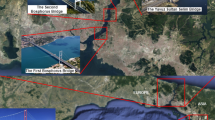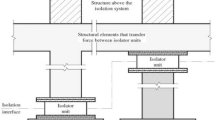Abstract
Bridges are the most useful part in the transportation network. Any disruption of the bridge structures may hamper the whole transportation system. In the last recent tsunamis, numerous number of bridges were structurally damaged by the tsunami waves. Lack of proper provisions of tsunami forces in the design guidelines also contributes to the augmentations of the damage level. Therefore, proper evaluation of the tsunami forces on the bridge girder should be introduced in the design promptly. In this study, laboratory experiments were carried out to reveal the damage mechanism of the bridge girder by assessing the exerted tsunami forces. Both broken and unbroken waves were considered for the analysis. The results showed that measured forces were larger for broken waves than those of unbroken waves. Maximum force of the broken waves was 4.59 times as large as the hydrostatic pressure. Also, waves reached the peak value more rapidly for larger wave heights than those of smaller ones. Additionally, a girder that is placed at a higher position is much vulnerable to tsunami hazard.
Similar content being viewed by others
References
Momenian A, Zekavat M. Seismic approach to urban design. Life Sci, 2013, 10: 184–189
Liu P L F, Lynett P, Fernando H, et al. Observations by the international tsunami survey team in Sri Lanka. Science, 2005, 308: 1595–1595
Michelin A, Lauciani V, Selvaggi G, et al. The 2010 Chile earthquake: Rapid assessments of tsunami. Eos, Transactions American Geophysical Union, 2010, 91: 305–306
Mori N, Takahashi T, Yasuda, T, et al. Survey of 2011 Tohoku earthquake tsunami inundation and run-up. Geophys Res Lett, 2011, 38: L00G14
NOAA. Tsunami data. National Data Buoy Center, National Oceanic and Atmospheric Administration, 2009 (Accessed on: 2013-8-5). http://www.ndbc.noaa.gov/dart.shtml
Spiske M, Piepenbreier J, Benavente C, et al. Preservation potential of tsunami deposits on arid siliciclastic coasts. Earth-Sci Rev, 2013, 126: 58–73
Synolakis C, Okal E. 1992–2002: Perspective on a Decade of Post-Tsunami Surveys Tsunamis. Springer, 2005. 1–29
Richmond B, Szczuciński W, Chagué-Goff C, et al. Erosion, deposition and landscape change on the Sendai coastal plain, Japan, resulting from the March 11, 2011 TŌhoku-oki tsunami. Sedimentary Geology, 2012
Richmond B M, Jaffe B E, Gelfenbaum G, et al. Geologic impacts of the 2004 Indian Ocean tsunami on Indonesia, Sri Lanka, and the Maldives. Tsunamis, hurricanes and neotectonics as driving mechanisms in coastal evolution, Zeitschrift für Geomorphologie NF Suppl, 2006, 146: 235–251
Bahlburg H, Spiske M. Sedimentology of tsunami inflow and backflow deposits: Key differences revealed in a modern example. Sedimentology, 2012, 59: 1063–1086
Bahlburg H, Weiss R. Sedimentology of the December 26, 2004, Sumatra tsunami deposits in eastern India (Tamil Nadu) and Kenya. Int J Earth Sci, 2007, 96: 1195–1209
Fritz H M, Kalligeris N, Borrero J C, et al. The 15 August 2007 Peru tsunami runup observations and modeling. Geophys Res Lett, 2008, 35
Goto K, Sugawara D, Ikema S, et al. Sedimentary processes associated with sand and boulder deposits formed by the 2011 Tohoku-oki tsunami at Sabusawa Island, Japan. Sedimentary Geology, 2012, 282: 188–198
Ballantyne D. Sri Lanka lifelines after the December 2004 great sumatra earthquake and tsunami. Earthquake Spectra, 2006, 22: 545–559
Iemura H, Pradono M H, Takahashi Y. Report on the tsunami damage of bridges in Banda Aceh and some countermeasures. In: the Proceedings of the 28th JSCE Earthquake Engineering Symposium. Tokyo, 2005
IIT. Quick Report on the Study of the 2004 Sumatra Earthquake and Tsunami Effects Department of Civil Engineering, Indian Institute of Technology Kanpur. Kanpur, India, 2011
Kusakabe T, Matsuo O, Kataoka S. Introduction of a methodology to mitigate Tsunami disaster by the pre-evaluation of Tsunami damage considering damage investigation of 2004 Tsunami disaster in the Indian Ocean. In: the Proceedings of the 21st US-Japan Bridge Engineering Workshop Tsukuba. Japan, 2005
Lukkunaprasit P, Ruangrassamee A. Buildings damage in Thailand in 2004 Indian Ocean tsunami and clues for tsunami-resistant design. The Institution of Engineers Singapore Journal, Part A: Civil Struct Eng, 2008, 1: 17–30
Maheshwari B K, Sharma M L, Narayan J P. Geotechnical and structural damage in Tamil Nadu, India, from the December 2004 Indian Ocean Tsunami. Earthq Spectra, 2006, 22: 475–493
Saatcioglu M, Ghobarah A, Nistor I. Performance of structures in Indonesia during the 2004 Sumatra earthquake and tsunami. Earthquake Spectra, Earthquake Engineering Research Institute, ASCE, 2006, 22: 295–320
Scawthorn C, Ono T, Iemura H, et al. Performance of lifelines in Banda Aceh, Indonesia, during the December 2004 great sumatra earthquake and tsunami. Earthq Spectra, 2006, 22: 511–544
Sheth A, Sanyal S, Jaiswal A, et al. Effects of the December 2004 Indian Ocean tsunami on the Indian Mainland. Earthq Spectra, 2006, 22: 435–473
Tobita T, Iai S, Banta C, Wimpie A. Reconnaissance report of the 2004 great sumatra-andaman, Indonesia, Earthquake: Damage to geotechnical works in Banda Aceh and Meulaboh. J Nat Disaster Sc, 2006, 28: 35–41
Yim S C. Modeling and simulation of tsunami and storm surge hydrodynamics loads on coastal bridge structures. In: Proceedings of the 21st US-Japan Bridge Engineering Workshop. Tsukuba, 2005
Unjoh, S. Damage to transportation facilities. The damage induced by Sumatra earthquake and associated tsunami of December 26, 2004. A report of the reconnaissance team of Japan Society of Civil Engineers, 2005. 66–76
Federal Emergency Management Agency (FEMA). Guidelines for Design of Structures for Vertical Evacuation from Tsunamis, FEMA P646 Report, prepared by the Applied Technology Council for the Federal Emergency Management Agency. Redwood City, California, 2008
Carrier G F, Yeh H. Tsunami propagation from a finite source. Comput Modeling Eng Sci, 2005, 10: 113
Okal E A. Normal mode energetics for far-field tsunamis generated by dislocations and landslides. Pure Appl Geophy, 2003, 160: 2189–2221
Federal Emergency Management Agency (FEMA). Coastal Construction Manual, FEMA 55 Report. 3rd eds. Federal Emergency Management Agency, Washington, D.C., 2005
Unjoh S. Bridge damage caused by tsunami (in Japanese). B Japan Assoc Earthquake Eng, 2007, 6: 6–28
Kosa K. Damage analysis of bridges affected by tsunami due to Great East Japan earthquake. In: Proceeding International Symposium on Engineering Lessons Learned from the 2011 Great East Japan Earthquake. 2012, 1386–1397
Kataoka S, Kusakabe T, Nagaya K. Wave force acts on a bridge girder struck by tsunami. In: Proceedings of the 12th Japan Earthquake Engineering Symposium, 2006. 154–157
Japan Port, Harbour Association. Technical standards and commentaries of port and harbour facilities 1999
Shoji G, Mori Y. Hydraulic model experiment to simulate the damage of a bridge deck subjected to tsunamis (in Japanese). Annu Coast Eng, 2006, 53: 801–805
Iemura H, Pradono M H, Tada T. Experiments of tsunami force acting on bridge models. J Earthq Eng, 2007, 29: 902–911
Lukkunaprasit P, Lau T L. Influence of bridge deck on tsunami loading on inland bridge piers. IES J Part A: Civil Struct Eng, 2011, 4: 115–121
Matsutomi H. Pressure distribution and total wave force when breakers and bores collide. Pro Coast Eng, JSCE, 1991, l: 626–630
Mizutani S, Imamura F. Hydraulic experimental study on wave force of a bore acting on a structure (in Japanese). Pro Coast Eng, JSCE, 2000, 47: 946–950
Asakura R, Iwase K, Ikeya T, et al. An experimental study on wave force acting on on-shore structures due to overflowing tsunamis. Pro Coast Eng, JSCE, 2000, 47: 911–915
Rahman S, Akib S, Khan M T R, et al. Experimental study on tsunami risk reduction on coastal building fronted by sea wall. Sci World J, 2014, doi:10.1155/2014/729357
Akib S, Fayyadh M M, Othman I. Structural Behavior of a Skewed Integral Bridge Affected by Different Parameters. Baltic J Road Bridge Eng, 2011, 6
Fayyadh M M, Akib S, Othman I, et al. Experimental investigation and finite element modelling of the effects of flow velocities on a skewed integral bridge. Simul Modell Pract Th, 2011, 19: 1795–1810
Araki S, Ishino K, Deguchi I. Characteristics of Tsunami Fluid Force Acting on Girder Bridge. In: Proceedings of the Twentieth International Offshore and Polar Engineering Conference. Beijing, 2010
Arnason H, Petroff C, Yeh H. Tsunami bore impingement onto a vertical column. J Disaster Res, 2009, 4: 391–403
Author information
Authors and Affiliations
Corresponding author
Rights and permissions
About this article
Cite this article
Rahman, S., Akib, S. & Shirazi, S.M. Experimental investigation on the stability of bride girder against tsunami forces. Sci. China Technol. Sci. 57, 2028–2036 (2014). https://doi.org/10.1007/s11431-014-5628-8
Received:
Accepted:
Published:
Issue Date:
DOI: https://doi.org/10.1007/s11431-014-5628-8




